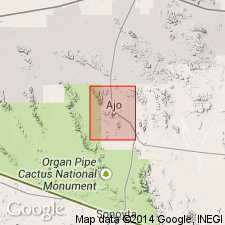
- Usage in publication:
-
- Concentrator volcanics*
- Modifications:
-
- Named
- Dominant lithology:
-
- Volcanics
- AAPG geologic province:
-
- Basin-and-Range province
Summary:
Named for exposures on Concentrator Hill. Is mapped south of Ajo in secs 23, 24, 25, 26, T12S, R6W, Pima Co, AZ in the Basin-and-Range province--an area of less than 2 sq miles. No type locality designated. Forms a rugged divide between Gibson and Cornelia arroyos. Also forms smooth even slopes. Variety of topographic forms reflect heterogeneous lithology. Separated from Cardigan gneiss (new) by faults. Intruded by Cornelia quartz monzonite (new). Unconformably overlain by Locomotive fanglomerate (new). Consists of flow breccias (most abundant), tuffs, and flows, all of which are quartzose. The rocks range from white to buff and gray to red and brown. Alteration has obscured the original character of the rock. Some andesite, quartz keratophyre, and quartz keratophyre tuffs. Source uncertain. Formation was probably originally andesitic and rhyolitic. Some of the minerals formed are characteristic of hydrothermal alteration. Is probably post-Paleozoic. A few limestone pebbles from Pennsylvanian? rocks found in some of the tuffaceous rocks. Tentatively assigned to the Upper Cretaceous because these rock types have been found in rocks assigned to the Cretaceous in nearby areas. Shown as Late Cretaceous? on geologic map.
Source: GNU records (USGS DDS-6; Denver GNULEX).
For more information, please contact Nancy Stamm, Geologic Names Committee Secretary.
Asterisk (*) indicates published by U.S. Geological Survey authors.
"No current usage" (†) implies that a name has been abandoned or has fallen into disuse. Former usage and, if known, replacement name given in parentheses ( ).
Slash (/) indicates name conflicts with nomenclatural guidelines (CSN, 1933; ACSN, 1961, 1970; NACSN, 1983, 2005, 2021). May be explained within brackets ([ ]).

